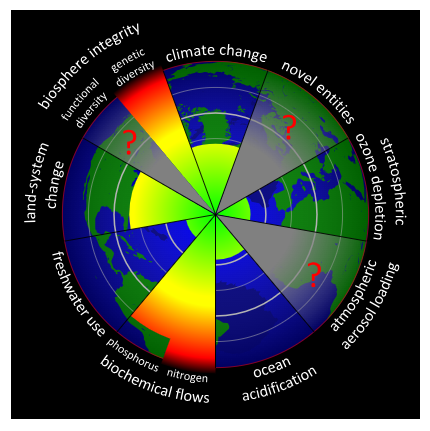Planetary Boundaries
1/3
There's no tags or description
Looks like no tags are added yet.
Name | Mastery | Learn | Test | Matching | Spaced |
|---|
No study sessions yet.
4 Terms
What is a planetary boundary?
Planetary boundaries define the safe operating space for humanity.
If one or more of these thresholds are exceeded, there is the possibility of abrupt and irreversible environmental change.
How are planetary boundaries represented?
Planetary boundaries are represented as circular graphs.
The safe operating space is in the centre, coloured green; further from the centre (coloured yellow) are those boundaries that are currently in danger of being exceeded; and the outer red are those boundaries that have already been exceeded.

How many planetary boundaries are there?
9.
State the 9 planetary boundaries.
Biosphere integrity- describes biodiversity loss and extinctions. The main cause for this is increased demand for food, water and natural resources. Habitats are being lost rapidly, e.g. coral reef bleaching caused by ocean acidification and rising temperatures. This boundary has already been exceeded.
Climate change- rising levels of carbon dioxide.
Chemical pollution and novel entities- describes the emission of toxic and long-lived substances, such as heavy metals, radioactive materials and synthetic organic pollutants.
Ozone depletion- : the ozone layer, a region of the stratosphere which shields the earth from UV radiation from the sun, has depleted in recent decades due to chemical pollution, e.g. CFCs from refrigerants and aerosols. Actions taken as a result of the Montreal Protocol, an international treaty signed in 1987, mean that this boundary has not been exceeded.
Aerosol loading- aerosols are atmospheric pollutants. Their effects in the atmosphere are complex and they have yet to be quantified.
Ocean acidification- this is owing to increased CO2 dissolving into oceans and forming carbonic acid. Organisms with calcium carbonate shells, like corals and molluscs can’t make shells in acid water. This has a knock-on effect on food chains and webs and could drastically reduce fish stocks. This boundary could be avoidable, but is approaching amber.
Biochemical flows- concern the nitrogen and phosphorous cycles. Both elements are fixed into fertilisers but up-take by plants is limited leading to eutrophication. The production and application of fertilisers continues to be a concern.
Fresh water use- not yet quantified. Nevertheless, globally fresh water is becoming scarce because of modification of water bodies and land use change. Desalination of sea water may ease the situation.
Land system change- this describes land converted to human use e.g. for agriculture. Globally this is approaching red.